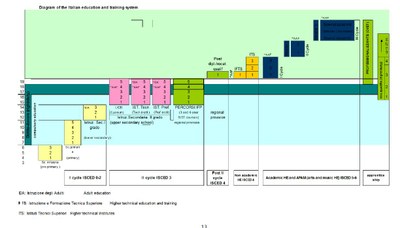Country report: chapter 2
Back to the country report navigation
2. Providing VET in a lifelong learning perspective
2.1. National Education and Vocational Training System Framework
2.2. Government-regulated VET provision
2.2.1. Three and four-year education and vocational training courses
2.2.2. Post-Secondary higher technical training system
2.3.1. Continuing VET training
2.3.2. Training provided by employers
2.3.3. Training programmes and providers
2.3.4. Adults' demand for non-formal and informal learning
| 2.2. Government-regulated VET provision | |
|---|---|
|
2.2.1. Three and four-year education and vocational training courses 2.2.2. Post-Secondary higher technical training system The post-secondary higher technical training system was recently reformed by the Italian Prime Minister’s Decree (2008) which contained guidelines for both the reorganisation of the higher technical education and training system (Sistema di istruzione e formazione tecnica superiore – IFTS) and the establishment of higher technical institutes (Istituti tecnici superiori – ITS). As a result, there are now two separate channels within the same system. From 2007 to today 519 courses were planned that meet the new standards. The vast majority of courses were held in the North, a lower number in the centre of Italy and only 56 in the South. The Higher Technician Diploma (EQF level 5) awarded by ITS courses covers one of the technological areas specified for each national reference profile. These areas have been further specified by an Inter-ministerial Decree (2011) In 2009 the Ministry of Education introduced a ‘Draft regulation for the reorganisation of teaching in adult education centres’ (Schema di Regolamento recante norme per la ridefinizione dell’assetto organizzativo didattico dei Centri d’istruzione per gli adulti). The document contains provisions for the establishment of training pathways leading to lower and 2.2.4. The apprenticeship system Apprenticeships are open-ended
In the first half of 2011 160 916 apprentices were employed; the most substantial drop was seen in the manufacturing, transport and communications sectors. 2.2.5. Teachers' and trainers' profiles Teachers and trainers have very different features in Italy as teachers' professional
2.2.6. VET provision quality assurance The accreditation of training institutions is to date the main tool for selecting the organisations that wish to provide training services, and consequently the main instrument available to the Regions and Autonomous Provinces, which are the only institutional bodies responsible for ensuring the quality of publicly funded training. The present, new accreditation model is due to a national agreement among the State and the Regions20 that took place in 2008. The national accreditation system comprises five criteria that provide As regards more specifically the use of monitoring and evaluation procedures, these are widely and sometimes even systematically used by the surveyed training organisations schema |
Overview of three and four-year vocational training course
Time sequence distribution of IFTS pathways per geographic area
ITS Technological areas and specific subsections
General features of VET teachers and trainers Legal status of the accredited training providers |
















